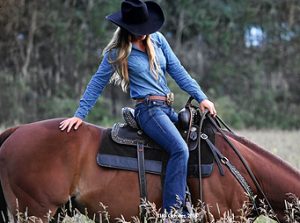Choosing the Proper Saddle Pad – It’s Harder Than You Think
Click here to read the complete article118 – October, 2018
BY MEGAN ARSZMAN
 We spend thousands of dollars on our horses: custom saddles, chiropractic work, massage therapy, proper shoeing, and regular dental care. We take the time to think about matching the color of our saddle blanket to our show clothes, but how many of us actually think about what’s going in between your horse’s back and the saddle?
We spend thousands of dollars on our horses: custom saddles, chiropractic work, massage therapy, proper shoeing, and regular dental care. We take the time to think about matching the color of our saddle blanket to our show clothes, but how many of us actually think about what’s going in between your horse’s back and the saddle?
“We buy very valuable horses, and we buy very valuable saddles, and yet we’re just putting a $30 pad on our horse’s back,” says AQHA Professional Horseman Robin Frid. “It does protect the horse from the saddle, but it doesn’t have any support or minimal support, especially as the pad ages.”
So how can you be sure you’re making the right choice when it comes to your saddle pad?
Thickness
Saddle pads come in a variety of thicknesses, from a ¼ inch to even 1½ inches. While some may feel that the thicker the pad, the better the protection, that’s not the case with the majority of horses. Pad thickness can affect how your saddle sits on your horse and how you ride. Depending on whether your horse lacks withers or has high withers, you could use a thinner pad to form better to a broader back or a thicker pad that can distribute the weight and pressure from the saddle over a more narrow back. “The horse’s shape is huge,” Frid says. “A thinner pad will rub a horse with higher withers more than a thicker pad will.”
If your horse is built downhill, keep in mind that he’s already struggling every step of the way. It isn’t easy for him, because he’s already carrying 60 percent of his weight on his front end. Now, he has to lift that, plus the saddle and the rider with every stride. “Ideally, I want a horse that runs a little uphill and helps shift the weight back to his hind end,” Frid says. “The horse going downhill is working with a deficiency from the get-go. Anything you can do to help them is not only going to make them move better, it’ll help them be more comfortable. And, if they’re more comfortable, they’re sounder.”
Click here to read the complete article118 – October, 2018










